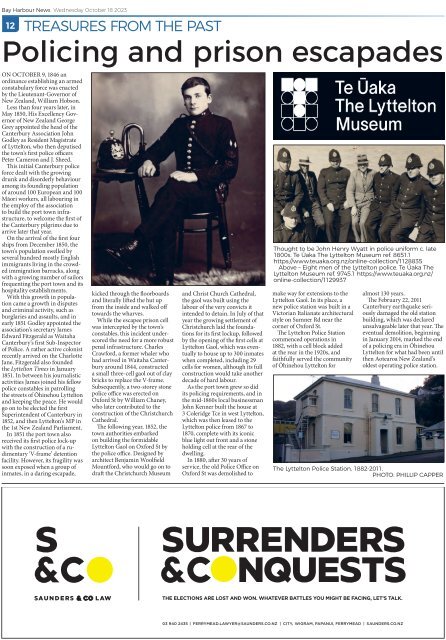Bay Harbour: October 18, 2023
Create successful ePaper yourself
Turn your PDF publications into a flip-book with our unique Google optimized e-Paper software.
<strong>Bay</strong> <strong>Harbour</strong> News Wednesday <strong>October</strong> <strong>18</strong> <strong>2023</strong><br />
12<br />
TREASURES FROM THE PAST<br />
Policing and prison escapades<br />
ON OCTOBER 9, <strong>18</strong>46 an<br />
ordinance establishing an armed<br />
constabulary force was enacted<br />
by the Lieutenant-Governor of<br />
New Zealand, William Hobson.<br />
Less than four years later, in<br />
May <strong>18</strong>50, His Excellency Governor<br />
of New Zealand George<br />
Grey appointed the head of the<br />
Canterbury Association John<br />
Godley as Resident Magistrate<br />
of Lyttelton, who then deputised<br />
the town’s first police officers<br />
Peter Cameron and J. Sheed.<br />
This initial Canterbury police<br />
force dealt with the growing<br />
drunk and disorderly behaviour<br />
among its founding population<br />
of around 100 European and 100<br />
Māori workers, all labouring in<br />
the employ of the association<br />
to build the port town infrastructure,<br />
to welcome the first of<br />
the Canterbury pilgrims due to<br />
arrive later that year.<br />
On the arrival of the first four<br />
ships from December <strong>18</strong>50, the<br />
town’s population swelled by<br />
several hundred mostly English<br />
immigrants living in the crowded<br />
immigration barracks, along<br />
with a growing number of sailors<br />
frequenting the port town and its<br />
hospitality establishments.<br />
With this growth in population<br />
came a growth in disputes<br />
and criminal activity, such as<br />
burglaries and assaults, and in<br />
early <strong>18</strong>51 Godley appointed the<br />
association’s secretary James<br />
Edward Fitzgerald as Waitaha<br />
Canterbury’s first Sub-Inspector<br />
of Police. A rather active colonist<br />
recently arrived on the Charlotte<br />
Jane, Fitzgerald also founded<br />
the Lyttelton Times in January<br />
<strong>18</strong>51. In between his journalistic<br />
activities James joined his fellow<br />
police constables in patrolling<br />
the streets of Ōhinehou Lyttelton<br />
and keeping the peace. He would<br />
go on to be elected the first<br />
Superintendent of Canterbury in<br />
<strong>18</strong>52, and then Lyttelton’s MP in<br />
the 1st New Zealand Parliament.<br />
In <strong>18</strong>51 the port town also<br />
received its first police lock-up<br />
with the construction of a rudimentary<br />
‘V-frame’ detention<br />
facility. However, its fragility was<br />
soon exposed when a group of<br />
inmates, in a daring escapade,<br />
kicked through the floorboards<br />
and literally lifted the hut up<br />
from the inside and walked off<br />
towards the wharves.<br />
While the escapee prison cell<br />
was intercepted by the town’s<br />
constables, this incident underscored<br />
the need for a more robust<br />
penal infrastructure. Charles<br />
Crawford, a former whaler who<br />
had arrived in Waitaha Canterbury<br />
around <strong>18</strong>44, constructed<br />
a small three-cell gaol out of clay<br />
bricks to replace the V-frame.<br />
Subsequently, a two-storey stone<br />
police office was erected on<br />
Oxford St by William Chaney,<br />
who later contributed to the<br />
construction of the Christchurch<br />
Cathedral.<br />
The following year, <strong>18</strong>52, the<br />
town authorities embarked<br />
on building the formidable<br />
Lyttelton Gaol on Oxford St by<br />
the police office. Designed by<br />
architect Benjamin Woolfield<br />
Mountford, who would go on to<br />
draft the Christchurch Museum<br />
and Christ Church Cathedral,<br />
the gaol was built using the<br />
labour of the very convicts it<br />
intended to detain. In July of that<br />
year the growing settlement of<br />
Christchurch laid the foundations<br />
for its first lockup, followed<br />
by the opening of the first cells at<br />
Lyttelton Gaol, which was eventually<br />
to house up to 300 inmates<br />
when completed, including 29<br />
cells for women, although its full<br />
construction would take another<br />
decade of hard labour.<br />
As the port town grew so did<br />
its policing requirements, and in<br />
the mid-<strong>18</strong>60s local businessman<br />
John Kenner built the house at<br />
3 Coleridge Tce in west Lyttelton,<br />
which was then leased to the<br />
Lyttelton police from <strong>18</strong>67 to<br />
<strong>18</strong>70, complete with its iconic<br />
blue light out front and a stone<br />
holding cell at the rear of the<br />
dwelling.<br />
In <strong>18</strong>80, after 30 years of<br />
service, the old Police Office on<br />
Oxford St was demolished to<br />
Thought to be John Henry Wyatt in police uniform c. late<br />
<strong>18</strong>00s. Te Ūaka The Lyttelton Museum ref. 8651.1<br />
https://www.teuaka.org.nz/online-collection/1128835<br />
Above – Eight men of the Lyttelton police. Te Ūaka The<br />
Lyttelton Museum ref. 9745.1 https://www.teuaka.org.nz/<br />
online-collection/1129937<br />
make way for extensions to the<br />
Lyttelton Gaol. In its place, a<br />
new police station was built in a<br />
Victorian Italianate architectural<br />
style on Sumner Rd near the<br />
corner of Oxford St.<br />
The Lyttelton Police Station<br />
commenced operations in<br />
<strong>18</strong>82, with a cell block added<br />
at the rear in the 1920s, and<br />
faithfully served the community<br />
of Ōhinehou Lyttelton for<br />
almost 130 years.<br />
The February 22, 2011<br />
Canterbury earthquake seriously<br />
damaged the old station<br />
building, which was declared<br />
unsalvageable later that year. The<br />
eventual demolition, beginning<br />
in January 2014, marked the end<br />
of a policing era in Ōhinehou<br />
Lyttelton for what had been until<br />
then Aotearoa New Zealand’s<br />
oldest operating police station.<br />
The Lyttelton Police Station, <strong>18</strong>82-2011.<br />
PHOTO: PHILLIP CAPPER<br />
URRENDER<br />
NQUE T<br />
THE ELECTIONS ARE LOST AND WON. WHATEVER BATTLES YOU MIGHT BE FACING, LET’S TALK.<br />
03 940 2435 | FERRYMEAD.LAWYER@SAUNDERS.CO.NZ | CITY, WIGRAM, PAPANUI, FERRYMEAD | SAUNDERS.CO.NZ


















